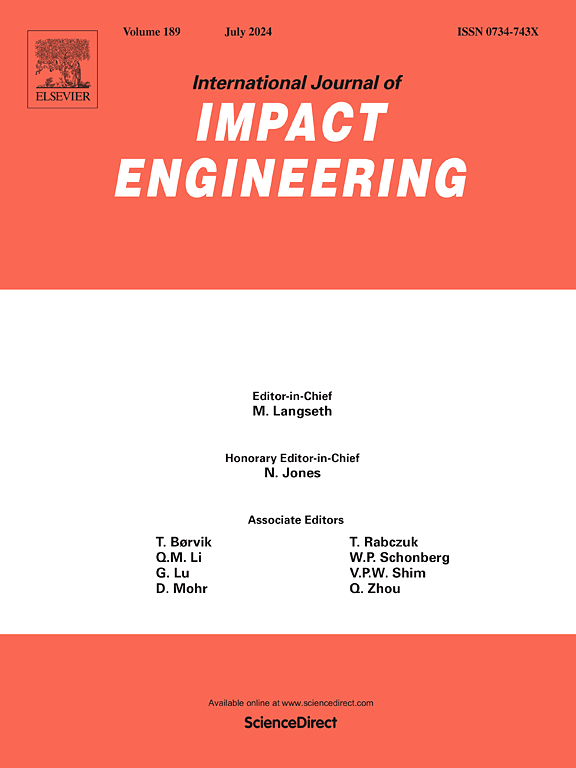Analysis of the impactor simulation modeling on the dynamic response of kinetic impact for asteroid defense
IF 5.1
2区 工程技术
Q1 ENGINEERING, MECHANICAL
International Journal of Impact Engineering
Pub Date : 2025-05-09
DOI:10.1016/j.ijimpeng.2025.105393
引用次数: 0
Abstract
Due to the limitations of simulation scale and computational time on resolution, simplified impactor models used in current kinetic impact defense simulations for asteroids often fail to accurately reproduce the complex impact responses caused by the internal structure of the real impactor. In order to investigate the influence of different impactor simulation modeling approaches on the impact response in kinetic impact defense for asteroids, a systematic comparison was conducted using the three-dimensional SPH method. The results show that different impactor modeling approaches can have a significant influence on the simulation results, with each simplified model failing to fully replicate the impact response of the real impactor. Compared to the real impactor, the momentum enhancement factor for solid aluminum spheres and low bulk density aluminum spheres is 10 % to 50 % higher. In terms of the ejection cone angle, the results for low solid density aluminum spheres tend to be larger than those for the real impactor, with the differences being more pronounced at early stages. In the study of the distribution of the azimuthal angle of the ejection momentum, the results for aluminum cubes with 90 % porosity are typically closer to those of the real impactor than those for aluminum cubes with 63 % porosity. However, the extremely high porosity also causes deviations in the ejected momentum distribution in scenarios of complete asteroid damage, differing from the real impactor. Therefore, when focusing on specific impact response results, simplified models with minimal errors can be selected. Among these, aluminum materials with 63 % or higher porosity offer the best overall performance as simplified impactor models, followed by low solid density aluminum materials. These findings provide experimental evidence for optimizing impactor modeling selection and clarify the applicable scenarios and limitations of different modeling approaches.
小行星防御用冲击器动力学响应仿真建模分析
由于仿真规模和计算时间在分辨率上的限制,目前用于小行星动力学碰撞防御仿真的简化撞击体模型往往不能准确再现真实撞击体内部结构引起的复杂撞击响应。为了研究不同的撞击体仿真建模方法对小行星动能撞击防御中撞击响应的影响,采用三维SPH方法进行了系统比较。结果表明,不同的冲击器建模方法会对仿真结果产生显著影响,每种简化模型都不能完全复制真实冲击器的冲击响应。与实际冲击器相比,固体铝球和低体积密度铝球的动量增强系数提高了10% ~ 50%。在弹射锥角方面,低固密度铝球的弹射锥角趋向于大于真实撞击体的弹射锥角,且在早期阶段差异更为明显。在抛射动量方位角分布的研究中,孔隙率为90%的铝立方体的结果通常比孔隙率为63%的铝立方体的结果更接近真实冲击体的结果。然而,极高的孔隙度也导致了在小行星完全损坏的情况下喷射动量分布的偏差,与实际撞击物不同。因此,当关注具体的冲击响应结果时,可以选择误差最小的简化模型。其中,孔隙率63%及以上的铝材料作为简化冲击器模型的综合性能最好,其次是低固密度的铝材料。这些发现为优化冲击器建模选择提供了实验依据,并阐明了不同建模方法的适用场景和局限性。
本文章由计算机程序翻译,如有差异,请以英文原文为准。
求助全文
约1分钟内获得全文
求助全文
来源期刊

International Journal of Impact Engineering
工程技术-工程:机械
CiteScore
8.70
自引率
13.70%
发文量
241
审稿时长
52 days
期刊介绍:
The International Journal of Impact Engineering, established in 1983 publishes original research findings related to the response of structures, components and materials subjected to impact, blast and high-rate loading. Areas relevant to the journal encompass the following general topics and those associated with them:
-Behaviour and failure of structures and materials under impact and blast loading
-Systems for protection and absorption of impact and blast loading
-Terminal ballistics
-Dynamic behaviour and failure of materials including plasticity and fracture
-Stress waves
-Structural crashworthiness
-High-rate mechanical and forming processes
-Impact, blast and high-rate loading/measurement techniques and their applications
 求助内容:
求助内容: 应助结果提醒方式:
应助结果提醒方式:


